Earth’s CO2 hits highest recorded level in human history
from independent.co.uk
Monthly average carbon dioxide (CO2) levels have reached above 420 parts per million (ppm) for the first time on record.
The new data, from Hawaii’s Mauna Loa Observatory, were released by the National Oceanic and Atmospheric Administration (NOAA).
Atmospheric CO2, driven higher in large part by burning fossil fuels around the world, is one of the major causes of the climate crisis.
Some climate scientists, including James Hansen, who famously alerted the US Congress to the perils of the climate crisis back in 1988, have previously called to reduce atmospheric CO2 below 350 ppm.
CO2 levels fluctuate over the course of the year, with highs around late spring. That’s due to the Northern Hemisphere’s seasons – as the northern summer comes in, increased plant growth pulls a lot of carbon out of the atmosphere, dropping levels lower.
But emissions from transportation, industry, electricity generation and other sources like deforestation have pushed vast quantities of CO2 into the atmosphere throughout the year since the mid-19th century – causing atmospheric carbon to increase dramatically over time.
Last year’s highest month, May, recorded 419.13 ppm. Twenty years ago, the highest month of the year had 375.93 ppm – and in 1958, the first year scientists started collecting CO2 data at Mauna Loa, the highest month of the year had just 317.51 ppm.
The Mauna Loa observatory is the longest continuous record of atmospheric carbon dioxide in the world.
NOAA notes that CO2 is currently increasing about 100 times faster than other periods in geological history that have seen more natural increases in carbon dioxide.
CO2 accelerates planetary warming by storing additional heat in the atmosphere, as opposed to letting it diffuse into space. More carbon in the atmosphere means less heat can escape – and the hotter the planet gets.
The latest report from the Intergovernmental Panel on Climate Change, the world’s leading authority on the climate crisis, notes that carbon dioxide from fossil fuel and industry makes up 64 percent of the world’s greenhouse gas emissions. Another 11 percent comes from emitted by land use and forestry.
The remaining emissions come from a few other greenhouse gases – some of which are even more potent than CO2 and have also been on the rise.
Methane, a gas more than 20 times as strong as CO2 when it comes to warming, recently hit 1908.9 parts per billion (ppb), up from around 1640 ppb in the early 1980s.
And nitrous oxide, which is hundreds of times more powerful a greenhouse gas as CO2, recently hit 335.2 ppb, up from around 316 ppb just twenty years ago.
The IPCC has cautioned that greenhouse gas emissions need to max out by 2025 at the latest if the world wants to keep warming to around 1.5 degrees Celsius.

